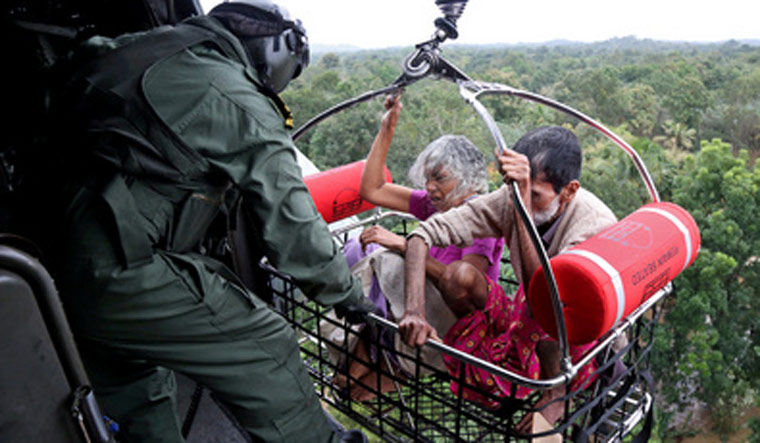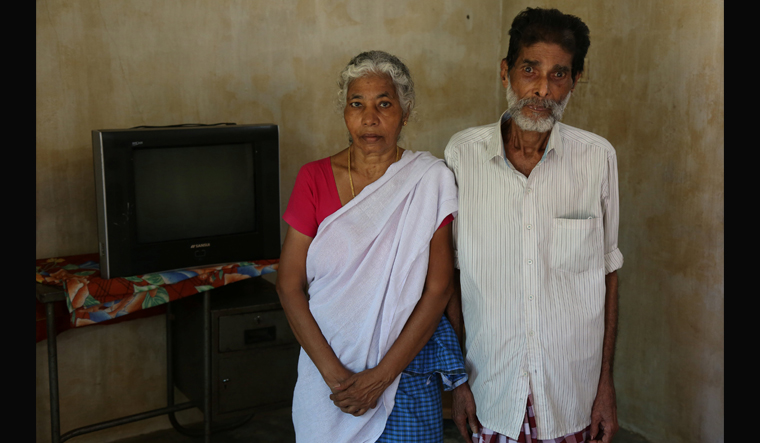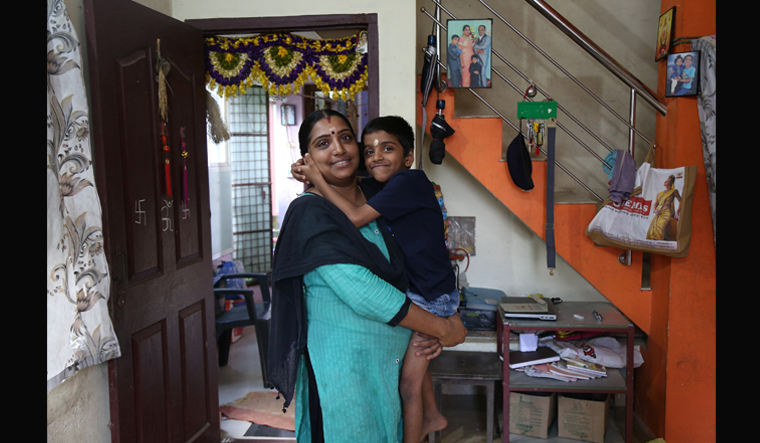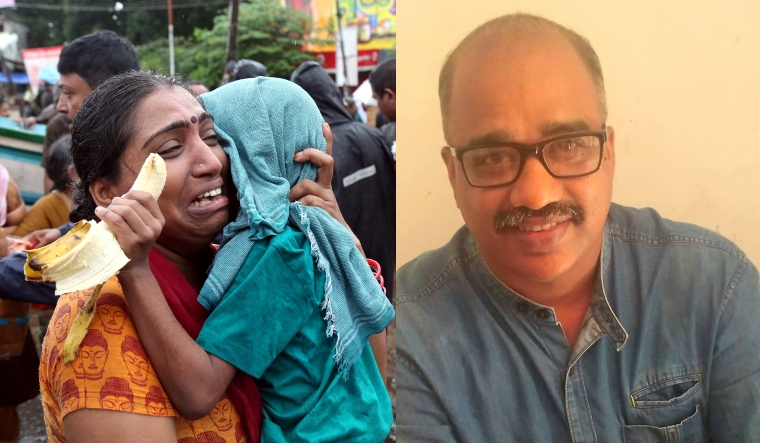On August 19, Kerala woke up to a picture of a mother clutching her son to her chest and sobbing her heart out, even as the child held a banana, tightly. They appeared to be tears of relief at having escaped the wrath of the flood, which had marooned them in the middle of a city.
Published on the front page of leading newspapers in the state, the picture became iconic and represented the suffering the floods inflicted on Kerala and its people. The photograph went on to be used by other national and international publications reporting on the Kerala floods.
The man who captured this emotional scene was Reuters photojournalist Sivaram Iyer. But, for Iyer, this was just another photograph that he took as part of his assignment. To him what was more important was to bring to the world the images of suffering and devastation in Kerala.
Reuters has now released a batch of photographs taken by Iyer depicting the 'before and after' scenes of the Kerala floods. One of the most noteworthy photographs is that of the mother and son, now safely back home.
Speaking to THE WEEK, Iyer said, “I had been monitoring the situation from August 9 itself. People were being asked to be alert. But it was on August 14 that all hell broke loose when all the dams were opened.” Initially, Iyer was at a loss to decide where to go and how to get there. He finally decided to head to Aluva.
It was difficult to reach there, said Iyer, who had to abandon his bike half way through, and reached Aluva on foot and after several lorry rides. “The first thing I felt when I reached there was the strong undercurrent of the flood water that was flowing on what used to be roads. I noticed that it was the locals who were carrying out all the rescue efforts. They had tied ropes on the sides of the roads, so that people could walk holding on to the rope without getting washed away,” said Iyer.
Armed with his camera, Iyer waded through the waters and hitchhiked on lorries to reach Nedumbassery. “When I reached the Cochin International Airport, it was completely submerged and people were breaking the walls on the perimeter, so that the water could flow easily. The airport was closed down on that day. The situation was turning dire,” Iyer recalled.
 Indira, 66, and Appukuttan Nair, 76, being airlifted during a rescue operation at Chengannur | Sivaram Iyer/Reuters
Indira, 66, and Appukuttan Nair, 76, being airlifted during a rescue operation at Chengannur | Sivaram Iyer/Reuters
Though the mother and child picture had become famous, there were other images, too, that melted hearts. On August 17, Iyer headed to Chengannur where, for the first time in his life, he flew in a Navy helicopter. “We were at Chengannur and a couple was airlifted from their neighbour's terrace. They used a metal basket because the couple had medical issues and the Navy could not risk individual rescue,” Iyer said. On August 18, the photograph of the elderly couple's rescue was featured as the lead image in newspapers. The couple can be seen sitting in a metal basket and hanging mid-air just outside a hovering helicopter as rescue personnel pull them inside.
But the image had a story of its own that followed in the days after the floods. While covering another part of the state after the flood, Iyer got numerous calls from an unknown number. It was the couple's son. “Apparently, he had been looking for his parents for several days, but could not find them at any of the relief centres,” he said.
He saw the photograph in the newspaper and somehow found Iyer's number. “I called the Navy personnel who had rescued them. The officer told me that since both the husband and wife had medical issues, they were directed to be dropped at the helipad in Chengannur. From there, they were taken to a hospital in an ambulance, under the instructions of the district administration. I was glad to relay the information to the couple's son who called later to thank me,” Iyer said. The couple, 66-year-old Indira and 76-year-old Appukuttan Nair, are now safely back home.
 Indira poses with her husband Appukuttan Nair inside their house in Chengannur, Kerala | Sivaram/Reuters
Indira poses with her husband Appukuttan Nair inside their house in Chengannur, Kerala | Sivaram/Reuters
The next day Iyer was back in Aluva again, but this time in a different area moving towards Kadungaloor. “It was there that I took the photograph of the mother and son. They had just been rescued with the help of the fishermen from Vizhinjam. The woman was already crying when I saw her. A boat had apparently overturned in front of them. She was still reeling under the shock of that sight,” Iyer said.
Her son, too, was bawling. He was taken from her arms and given a banana by the rescue personnel, but that failed to console him. The child was then handed back to the mother, who then hugged him tightly. “It was this moment that I captured. It was truly an emotional scene. She was crying uncontrollably, maybe from relief, maybe from shock.”
A month later, he was able to track down the woman and her family. But Lakshmi, 35, was sceptical about letting Iyer take another photo. “She said she had got enough attention after the first photograph. Lots of people had called her to ask if she was okay. Even I got messages on Facebook from people who knew her,” he said.
 Lakshmi, 35, poses with her son Sreehari, 6, inside their house in Aluva, Kerala | Sivaram/Reuters
Lakshmi, 35, poses with her son Sreehari, 6, inside their house in Aluva, Kerala | Sivaram/Reuters
Thankfully, Iyer was able to convince her. “I told her it would be a message to everyone who were concerned about her. This would be the easiest way of letting people know that you are okay. She finally agreed and let me photograph her with her son,” he said.
On August 19, Iyer again got a chance to fly in a helicopter. “This time, we headed towards the Kottayam-Changanassery area. I really understood the extent of devastation caused by the floods then. The aerial view we get from the helicopter is completely different. We cannot distinguish between a road and a river. Everything was under water. All the houses, temples, buildings, everything was swallowed by the flood. It was a sorrowful sight,” Iyer concedes.
 A aerial view of flooded paddies and marooned homes | Sivaram/Reuters
A aerial view of flooded paddies and marooned homes | Sivaram/Reuters
Communicating with those on the ground proved to be difficult. “The helicopter is really loud and there is a limit to how low they can fly,” Iyer said. “They used to display placards in Malayalam asking what people on the ground needed. They would be asked whether they wanted food, medicine or to be airlifted,” he added.
But Iyer remembered that some people wanted the helicopters to go away. “It causes lot of wind and people were afraid of that. The rescue personnel in helicopters were often asked to leave. It was really sad to see because they were taking a great risk by flying low to rescue them,” he said.
Soon, water started receding and Iyer switched to covering relief camps and the cleaning process that had started by then. “It was then that I thought of doing a 'before and after' series to show the impact of the floods. I identified a batch of photographs that I wanted to follow up on. Then, depending on the light and the availability of the people, I revisited the places and took the second set of photographs,” he reveals.
For Iyer, covering the Kerala floods was the toughest and saddest assignment. “Tough because there was no way of reaching all these places. Entire Kerala was under water and I could not even reach half of these areas. As a photojournalist, it is a very important factor,” he said.
“Sad because so many people lost all their belongings. Those in the cities with jobs have at least their salaries and bank balances. But those in the rural areas have lost everything. They have nothing to fall back on,” Iyer said. But he is all praise for the willpower of the affected.
“Though they lost everything overnight, they were more focused on rebuilding their lives. Keralites are a hardy set of people,” Iyer declares.



